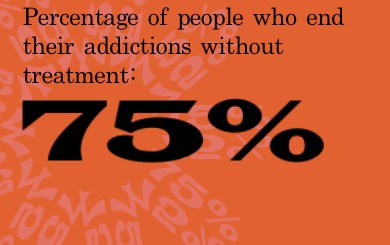A reader recently commented:
I question the validity of your statistic that 3/4 of people with substance abuse problems achieved sobriety without any treatment
I know it doesn’t fit with common wisdom, but I stand behind this basic statement that I’ve made all over this website: “at any given time, 75% of addicts have recovered from addiction, and most have done it without treatment” (please excuse the disease based terminology I used there). I offer a detailed analysis of one study supporting this view here: http://www.thecleanslate.org/self-change/substance-dependence-recovery-rates-with-and-without-treatment/
 In that specific study, a representative population of people who have ever had “alcoholism” were studied (more than 4,000 surveyed), and of the total, 75% of them had recovered from alcoholism (through both abstinence and various levels of moderation)and most of them didn’t get treatment (75% sought no help, and then of the remaining 25%, they got help for their drinking from different sources [AA, doctors, religion, formal treatment programs, etc], with only half of that group actually getting specialty addiction treatment). In both treated and untreated groups, about 75% “recovered”. These results were replicated in 2 nearly identical studies (NLAES and NESARC) done 10 years apart by the NIAAA in 1992 and 2002 – giving us good reason to trust the results.
In that specific study, a representative population of people who have ever had “alcoholism” were studied (more than 4,000 surveyed), and of the total, 75% of them had recovered from alcoholism (through both abstinence and various levels of moderation)and most of them didn’t get treatment (75% sought no help, and then of the remaining 25%, they got help for their drinking from different sources [AA, doctors, religion, formal treatment programs, etc], with only half of that group actually getting specialty addiction treatment). In both treated and untreated groups, about 75% “recovered”. These results were replicated in 2 nearly identical studies (NLAES and NESARC) done 10 years apart by the NIAAA in 1992 and 2002 – giving us good reason to trust the results.
But it’s not just these studies that my opinion is based on. There are more, and Harvard’s Gene Heyman does a better job of explaining this than me in most respects, he covers these similar studies in his brilliant book (Addiction: A Disorder of Choice). Here are some quotes from his review of much of the evidence:
There are four large national studies that recruited representative populations and provide data relevant to relapse and remission rates for addiction…
Epidemiological Catchment Area stude (ECA):
…at approximately age 24 more than half of those who ever met the criteria for addiction no longer reported even one symptom, and that by about age 37 approximately 75 percent of those who ever met the criteria for dependence were no longer reporting any symptoms. Since dependence requires at least three symptoms over a twelve-month period, it is likely that the proportion of those in their thirties who were still dependent was actually less than 25 percent….
National Comorbidity Survey:
The NCS reported that 74 percent of lifetime addicts were in remission…
And then he brings up the NLAES and NESARC data which I offered an analysis of, and compares it with the 2 previous studies mentioned:
The results are similar to the earlier results. Indeed the remission rates are slightly higher than reported in the first NCS study. Although the surveys were carried out in three different decades-the eighties, nineties, and aughts-with different populations, in different geographic regions of the country, and by different interviewers, they converge on the same result. Most individuals who met the criteria for lifetime addiction were no longer addicted at the time of the survey. Given the median age of the subject populations and the data presented in Figure 4.1, it is highly likely that most stopped using drugs at clinically significant levels in their late twenties or early thirties. High remission rates are a stable feature of addiction.
The high remission rate he’s referring to is right at about 75% taking all the studies together, and these studies have collectively looked at tens of thousands of people with histories of addiction. It’s important to remember that these studies he discussed didn’t look at just people from rehab clinics, as much of the research does – they looked at all people with histories of addiction. It is widely accepted that “not enough people get treatment” and statements such as “9 out of 10 addicts never get treatment” are commonplace, and are shown through research. Particularly, SAMHSA’s annual National Survey on Drug Use and Health studies bear these approximate statistics out every year. So, taking as fact that only a small portion of people get treatment, and that when we look at all addicts (and thus we’re looking at mostly people who haven’t been treated) most of them recover, then it’s basically safe to say that most people recover without treatment. In fact, I think it’s safe to say that 3 out of 4 people recover without treatment. This is my opinion, based on the data I’ve seen.
